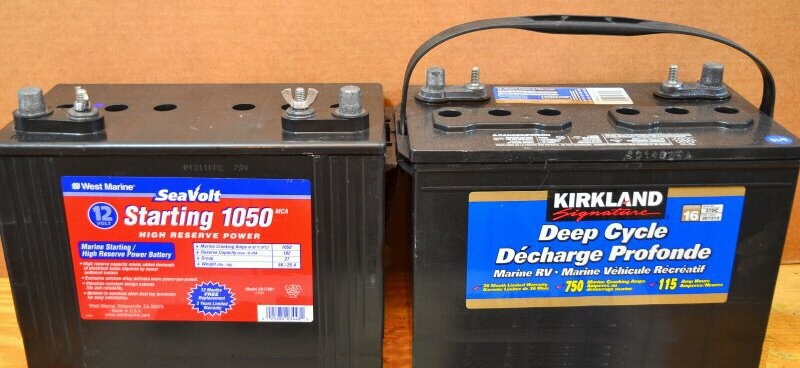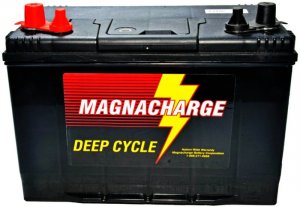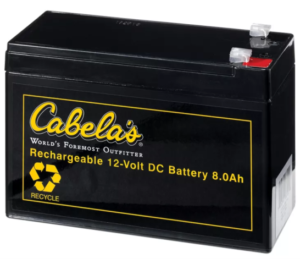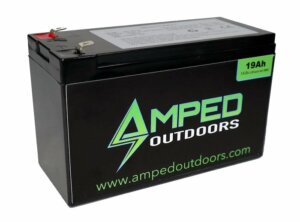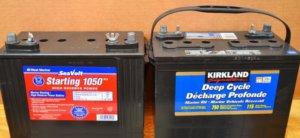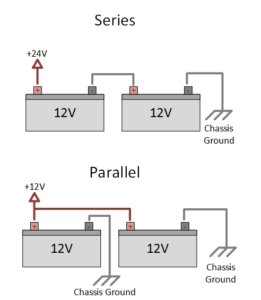Calculating Run Time
How Long Will Your Lights Run?
“Deep Cycle Batteries” should always be used to power your lights. “Starting” Batteries of any kind are not designed to “Recycle” and will not hold a charge for long periods of time. “Starting” Batteries have much thinner internal plates and will run down much faster than “Deep Cycle” Batteries which have much thicker internal plates and are designed to be charged and discharged over and over again. Your lights are only as good as your batteries so be sure to use a good “Deep Cycle” battery for your lights. A true “Deep Cycle” Battery will have the “Amp Hour” Rating on it. Amp Hours and Cranking Amps are NOT the same thing!
A Simple Formula to find out how long a light will run off of your particular battery is to take the batteries “amp-hour rating” and divide it by the total amps being pulled from the battery per hour. (Amp Hour Rating of Battery / Total Amps = Total Run Time). For example, a 30-watt COB draws about 2.5 amps., so a 8 amp hr. battery would run the light for about 3.2 hrs. (8/2.5= 3.2)
Full Size Deep Cycle Batteries
| Battery Type | Amp Hour Rating | Voltage |
|---|---|---|
| Group 27 | 100-115 Amp Hours | 12 Volts |
| Group 29 | 110-125 Amp Hours | 12 Volts |
Compact Deep Cycle Batteries
For those of you who need a smaller battery that will fit in a back pack, the compact batteries listed below will provide good light for a limited amount of time. Most compact batteries such as the 8-amp hour rechargeable battery from Cabela’s and many of the compact batteries from Amped Outdoors come with ‘Spade Clip” connections. We offer Spade Clip with S4 Connection on our Accessory Page.
To find out how long a light will run on any given battery you take the Amp Hour rating of the battery and divide it by the amp draw of the light. For example, a 30-watt COB draws about 2.5 amps., so a 8 amp hr. battery would run the light for about 3.2 hrs. (8/2.5= 3.2)
Starting Batteries vs Deep Cycle Batteries
Both “Starting” batteries and most “Deep Cycle” batteries are lead-acid batteries that use exactly the same chemistry for their operation. The difference is in the way that the batteries optimize their design:
A “Starting Battery” is designed to provide a large amount of current for a short period of time.
This surge of current is needed to turn the engine over during starting. Once the engine starts, the alternator provides all the power that the car needs, so a starting battery may go through its entire life without ever being drained of more than 20 percent of its total capacity. Used in this way, a starting battery can last a number of years. To achieve a large amount of current, a starting battery uses thin plates to increase its surface area.
A “Deep Cycle Battery” is designed to provide a steady amount of current over a long period of time.
A Deep Cycle Battery can provide a surge when needed, but nothing like the surge a car battery can. A deep cycle battery is designed to be deeply discharged over and over again (this is something that would ruin a car battery quickly). To accomplish this a deep cycle battery uses thicker internal plates which hold the charge for longer periods and will not deteriorate over time.
A Starting Battery typically has two ratings: CCA (Cold Cranking Amps) – The number of amps that the battery can produce at 32 degrees F (0 degrees C) for 30 seconds. This is important when starting a cold engine which needs a lot of power for a short amount of time. These batteries are intended to be fully charged and maintained with an alternator. They will fail quickly if ran completely down and recharged multiple times because the internal plates are much thinner than the plates in Deep Cycle Batteries.
RC (Reserve Capacity) – The number of minutes that the battery can deliver 25 amps while keeping its voltage above 10.5 volts.
Typically, a Deep Cycle Battery will have two or three times the RC of a Starting Battery, but it will deliver one-half or three-quarters the CCAs. In addition a deep cycle battery can withstand several hundred total discharge/recharge cycles, while a Starting battery is not designed to be totally discharged before recharging.
The bottom line is… Use “Deep Cycle Batteries” for your lights and trolling motor, and a “Marine Starting battery” for starting your boat.
Notice: For best performance a Group 27, 115 amp hr. Deep Cycle battery or better is recommended. While these lights are extremely bright, they require sufficient amperage to operate at maximum brightness. If you are using a generator or have an AC outlet on your dock, you can power your 12VDC lights with a AC to DC converter. Always use a converter that puts out more amperage than you need. The more amperage…the brighter the light will be!
Linking your batteries – Parallel vs Series
Be sure you connect your batteries correctly!

